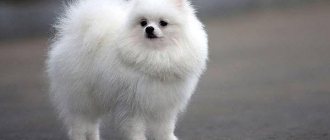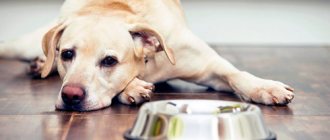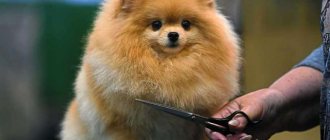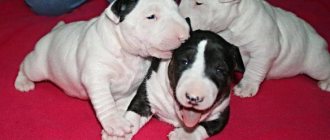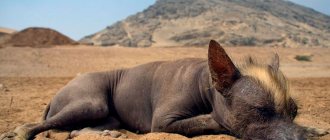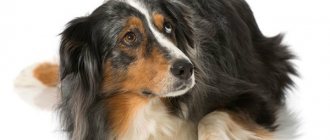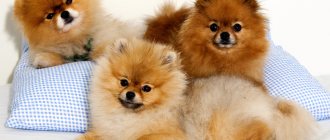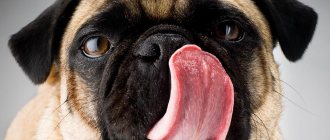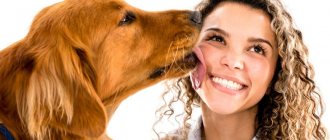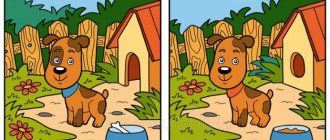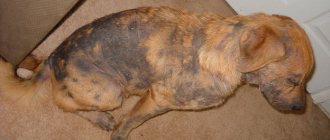The history of the origin of the decorative dog
Havanese Bichons are a relatively young breed. The exact history of origin is unknown, there are two versions. The first of them says that these dogs originated from lapdogs from the island. Malta. In the 17th century Spanish colonialists brought Bichons from Bologna (Italy) to Malta and the Caribbean islands. As a result of crossing these two breeds, the Havanese Bichon, which is also called the Havanese or Havanese, appeared.
Bichon Havanese - a magnificent variety of colors
For your information! These decorative dogs were very popular with the highest nobility. Cuba. The Havanese Bichon is considered the national dog of Cuba. At the beginning of the 20th century. this breed had lost its former popularity and was in danger of extinction, but American breeders began to actively breed Havanese Bichons.
According to the second version, the ancestor of modern Havanese were Havanese lapdogs (Bichon Tenerife), who lived in the Canary Islands. These animals were crossed many times with poodles, spitz dogs and other varieties of lapdogs. The result of numerous crossings was the appearance of the Havanese breed. They are completely different from the European lap dogs of the late 19th century. - beginning of the 20th century
Havana Bichons were a favorite among Americans and Cubans. In 1980–1990 This breed was brought to Europe, where it quickly won the hearts of many animal lovers.
Note! In former times, these dogs tended herds and took part in circus acts. Today they have become ideal companions and friends of people.
Affectionate decorative dogs have become everyone's favorites
Brief historical background
The exact origin of the Havanese Bichon, like other closely related breeds, is not known for certain to science. According to one of the most common versions, they are the result of a natural crossing of French and Maltese lapdogs with a poodle . At the end of the 15th century, these dogs, along with Spanish settlers, sailed to Liberty Island on ships. For many decades, the breed was formed in almost complete isolation. Small shaggy dogs were extremely popular among both aristocrats and commoners.
The ancestors of the Havanese were Maltese and French lapdogs, very popular in the Middle Ages
The Havanese lapdogs experienced difficult times during the period of political crisis; after the Cuban revolution (1959) and the change of regime, they teetered on the brink of extinction and almost disappeared. Along with the flow of immigrant refugees seeking to start a new life in America, the animals were taken to the United States. It was from these dogs that the modern Havanese originated.
The population has been restored. In 1996, silky dogs, as they were called in their historical homeland, were recognized by the world canine community, calling them Havanese Bichons. The current standard was developed and adopted in 1998.
In the FCI registry, Havanese are classified in group 9 - decorative dogs and companion dogs (section 1 - bichons and related breeds), they are assigned the number 250.
Description of the Havanese breed
"Havanese" are very sweet and gentle. Their beauty will not leave anyone indifferent. The Havanese is a dog whose breed description contains many details. She has a rather bright appearance, so it is difficult to confuse the Havanese with another breed.
Bichon Frize: description of the dog breed, character
Decorative Havanese dogs differ from each other in coat color. The varieties of colors are very diverse:
- white;
- black;
- cream;
- brown;
- pale yellow;
- tobacco;
- apricot;
- grey;
- black and white;
- black and tan;
- mahogany.
Note! Pure white coloring in these dogs is very rare.
Description of the Havanese Bichon breed according to the standard:
- height at withers 21–29 cm;
- long, thick, wavy coat, soft to the touch, silky;
- floppy ears. The fur on them is slightly darker and thicker than on the body and legs. The ears are located far from each other;
- thin, tightly closed lips. Wide big nose;
- weight varies from 3.5 to 7.3 kg;
- strong bones. Dense, but small and elegant body. The body is proportionally harmonious;
- small round head;
- not too noticeable transition from the muzzle to the forehead;
- short muzzle;
- the long neck smoothly transitions into the body;
- dark brown or black eyes;
- dark space around the eyes, black eyelids;
- tail in a ring, set high on the rump. It is about half as long as the back;
- graceful springy gait;
- scissor bite. The incisors may be deployed or not parallel to each other;
- The hind legs are slightly longer than the front legs.
Important! The Bichon Havanese lives 13–15 years. He will become a wonderful companion and loyal friend to his owner.
To keep the hair out of the way, you can tie it on the top of your head with a hair tie.
Application
The Bichon is widely used as a companion for single people. A dog will brighten up the loneliness of an elderly person; in addition, close communication with an animal is beneficial for the owner’s well-being.
Kinestherapy is one of the newfangled branches of alternative medicine. Many balneological centers use the method of treatment by communicating with animals. The Havanese Bichon dog breed is considered the most promising in this direction.
The beneficial effects of contact with animals on the activity of the nervous and cardiovascular systems have been scientifically proven. In a family with children, the dog will become a friend in games, and sometimes in pranks. The dog is ready to have endless fun, which brings him closer to children. Although the Bichon is small in size, it can very well play the role of a watchman. A ringing and loud bark will warn the family that guests are approaching.
Breed characteristics and character
Labrador Retriever: description of the dog breed
The Havanese is an incredibly playful, cheerful, and cheerful dog. She gets along well with all family members and other pets. She has a light and pleasant character. These dogs are very attached to their owners and get bored without them. Open and simple-minded Havanese Bichons have a hard time with loneliness. They are smart, quick-witted and easy to train. These dogs can play endlessly with children. Sometimes they become overly playful and restless, this is a sign of fear and excitement, because these dogs are very timid.
Note! Havanez subtly sense the owner’s mood and always know when he is happy or upset about something. These dogs are happy when they are praised and sad when they are scolded. They cannot stand being treated rudely and may become offended by their owner.
Despite their almost toy-like appearance, Bichons are incredibly brave and can be excellent guards. They will not miss an opportunity to demonstrate their dog's loyalty to their owner.
You need to brush your fur every day
Relationships with other pets
Loving, sociable and friendly, Havanese Bichons do not experience any problems in relationships with other dogs, cats, and birds. Life experience shows that all these animals get along well with each other in the same apartment.
Raising Cuban Bichons
Havanese dogs are amazingly smart creatures, the leitmotif of whose life is to please their owner. Raising a Havanese will not create difficulties or problems even for a beginner. Cubans instantly learn the requirements and rules of residence and try to comply with them. They socialize easily. In love with the owner and all members of his family, the dogs are easily trained: they learn commands and learn simple tricks.
Being the brightest representative of decorative exotics, the Havanese Bichon is surprisingly effective in sports disciplines: agility, flyball, freestyle, obedience.
In America, Cuban Bichons are involved in projects:
- Canistherapy (method of treatment and social adaptation of sick people with the help of specially trained dogs);
- accompanying as a guide dog for a visually impaired person;
- search for drugs and explosives.
Education and training
Havanez are smart and inquisitive, quickly learning new things. Training them is not at all difficult and very pleasant. The puppy must be taught all commands. It is very important that you learn to never pick up anything on the street. With a dog, you need to especially carefully work out those commands that prohibit any action.
Important! If a Bichon is not trained and overly pampered, it will become capricious and wayward, so sufficient attention must be paid to training and education.
Graceful and smooth movements of the dog
Price
Let’s say right away that there are few representatives of the breed in question in Russia and the CIS countries. Those who fully comply with the international standard are bred only in nurseries. Therefore, if you want to become the owner of just such a pet, and not a cute mongrel with a dubious character, we advise you to look for just such an institution. The price of a Havanese Bichon with a pedigree ranges from $500 to $1,000. Finding a cheaper option is unlikely.
Hygiene and grooming
The luxurious long coat requires careful grooming. The caring owner constantly monitors her condition. Any change could be a sign of illness. The Havanese Bichon's coat cannot be cut, but must be brushed daily. For this you will need a quality brush. Bichons shed in the fall and spring, during which time they need to be brushed 2-3 times a day. The rest of the time they constantly continue to lightly shed.
Twice a month, the Bichon's coat should be washed with special shampoos and treated with conditioners. These dogs have no dog smell. They love warm weather. Despite their thick, long hair, Bichons cannot tolerate frost, so in cold weather they need to be dressed in overalls. To prevent the hair next to the Bichon's eyes from being disturbed, it can be tied with an elastic band.
Important! Eyes need to be examined every day. If dirt gets into them, wash the eyes with a cloth moistened with warm water.
Ears need to be looked after especially carefully. The fur inside them needs to be cut off so that it does not clog the ear canal. Every 2-3 weeks, you should clean your ears with a soft, damp cotton swab to remove earwax.
Every day, the owner must brush the Bichon’s teeth with a special paste and brush. Fresh tomatoes added to food will protect your pet from tartar.
After walks, be sure to wash your paws and claws. Once every 2 weeks, you need to trim your bichon's claws if he doesn't walk much and doesn't have time to grind them down. The tip of the claw is trimmed with a nail clipper and then filed with a nail file. You need to cut no more than 1–2 mm so as not to injure the dog’s finger.
Expressive eyes of a kind dog that gets along well with children and other pets
Wise choice and price of a puppy
Havanese puppies are sold 2-3 months after birth. There are a number of tips to help you choose a worthy pet:
- the animal must be active, ready to play and run;
- the color will not change, you need to pay attention to this before purchasing;
- if there are pigment spots, they will also remain;
- the puppy should not limp;
- Ideally, the coat is smooth, shiny, without bald spots.
You should carefully palpate your four-legged friend so that he does not experience pain during palpation. It is advisable to buy a puppy from trusted breeders or kennels with a good rating. The seller must have documents for the dogs and pedigree. The price ranges from 300-500 conventional units . You can find a pet at a cheaper price, as long as it is not sick.
Advice! Each puppy sold must have an individual metric, where the name and brand number are written. It is applied to the groin area, in numerical or letter form. The document also contains information about the breeder, buyer or nursery.
A conscientious seller will supervise the puppy after its sale. He will advise you on the necessary issues and provide assistance in the future.
The Havanese Bichon is a loyal, intelligent, sociable dog breed. They suffer alone, but if you surround the animal with attention, it will reward you with affection and love. It is important to analyze your budget, as you will need to periodically groom your dog and buy food. In the absence of proper nutrition, the animal will get sick and its emotional state will suffer. If you don't take care of the coat, the dog will be in tangles and will look unkempt. Dealing with long fur requires patience. If you don’t want to care for your pet, you shouldn’t buy a lapdog.
How to feed a Havanese Bichon
The Havanese Bichon loves to eat, but should not be overfed. The dog's appearance and well-being depend on the quality of its diet.
The diet should include a variety of foods:
- meat;
- fruits;
- vegetables;
- porridge from cereals and cereals.
The diet should be balanced and include all the necessary nutrients.
Note! You can feed your dog either natural food or special food (dry and wet). Your dog should always have a bowl of clean drinking water. The Havanese Bichon should be fed 2-3 times a day, and the water in the cup should be changed twice a day.
Bichon should not eat:
- human food, table scraps;
- baking;
- smoked products;
- sweets;
- salty;
- spicy.
Small puppies under 1 year of age require high-calorie food rich in protein. They need to be fed more often than adult dogs, 6 times a day.
Good care of eyes, ears, claws, and coat is required
How to choose a puppy
- The number of Havanese dogs in Russia is still small, so pay great attention to choosing a nursery. As an option, take a ride through the Baltic countries, where the breed began to be bred a little earlier.
- Try to communicate with the puppies' mother and the rest of the litter. Pay attention to how the Bichon you like behaves with its fellow tribesmen - whether it leads or obeys.
- Test the puppies for friendliness. Lift the little furry off the floor and evaluate his actions. If your baby squeals and tries to bite you, this is a sign of an unstable psyche. Remember, the Havanez is not a “servant”, and it is unusual for him to show aggression.
- Ask the seller not only for the pedigrees of the producers, but also for the results of their examination for hereditary diseases. In particular, for elbow and hip dysplasia.
- Always give importance to the appearance of the offspring. Puppies should be well-fed, with clean, smooth fur, without signs of an umbilical hernia or signs of diarrhea under the tail. Uniformity of the litter is encouraged, and one puppy will always be larger than the rest.
Walking and physical activity
Havanese Bichons do not need long walks. Many of them like to stay at home. These dogs need to be taken outside to the toilet, but they can be trained to use a litter box and a diaper. When walking your dog, you need to play with him a little, let him run around and frolic. This is a sociable dog, so it will happily play with other dogs. The average duration of a walk can be 20–40 minutes.
Important! In winter, the Bichon must wear warm overalls.
Mating, pregnancy and childbirth
Female Havanese Bichons begin to go into heat between 6 and 12 months of age and repeat every 6 to 9 months. Never breed a female dog in her first heat: the body of a recent puppy is not yet strong enough to bear offspring. Find out the duration of estrus specifically for your dog: to do this, observe the bitch more than once or twice. Typically this period is 20 - 22 days. It is better to breed with a male dog on the 11th - 15th day and again a day later - two. Mating is best done in the boy's territory. It is ideal if the animals are comparable in height. But if the difference is big, place a pillow under the hind legs of the dog or bitch.
The Havanese Bichon's pregnancy lasts 59 ± 3 days. It is important to know exactly the gestational age, since prematurity and postmaturity threaten the puppies with death. To do this, always write down the mating dates. Young dogs (up to 3 - 4 years old) have small litters, which is why pregnancy may last longer than usual. In the first three weeks, the bitch’s behavior changes (she becomes more affectionate), but there are no external signs. After a month, the belly grows and the mammary glands enlarge.
Signs of imminent labor:
- prolapse of the abdomen,
- greenish or yellowish discharge from the loop,
- decrease in rectal temperature to 37 degrees and below.
Prepare your birth kit:
- disposable diapers (put under the bitch),
- ironed cloths (to receive and dry puppies),
- dishes (put away afterbirth),
- a box for puppies with a heating pad (if the bitch is restless, and newborns should not be placed in it),
- surgical clamp and scissors (for cutting the umbilical cord; treat with alcohol),
- antiseptic spray Septonex, Aluminum or Xidikol (for treating the umbilical cord wound),
- scales, notebook, pen, thick thread of floss (weigh and mark puppies, write down the results).
If the birth is successful, then no medications or other means of resuscitation are needed. If not, the veterinarian you call will have everything you need with you.
Reproduction and lifespan
Havanese Bichons are long-lived compared to many other dogs. Havanez live 13–15 years. Adult healthy dogs are bred for mating. It is very important that they are not related to each other, but are well acquainted with each other. Mating is carried out on the 4th day of estrus.
You need to carefully monitor your pet's health
Nutrition
A Havanese Bichon puppy needs to eat plenty of meat and dairy products to ensure its skeleton and muscles develop properly. It is recommended to finely chop chicken or rabbit meat for him every day (mono combine), and also give him fresh cow's milk.
Thanks to regular consumption of proteins, the dog progressively gains muscle mass and becomes healthier. We also recommend giving her soups, borscht and broths to improve digestion. In addition, you can include in your pet’s menu:
- Cereals.
- Mashed potatoes.
- Berries, vegetables and fruits.
- Fish (without bones).
But you can’t give him sweets and smoked foods. Remember, the Cuban lapdog is an excellent manipulator, who, at the sight of a delicious cake, can look at you pitifully and whine, begging for it. You can't agree!
After eating difficult-to-digest and high-carbohydrate foods, dogs experience digestive dysfunction. When the puppy turns 1.5 years old, we advise you to change his diet from natural to ready-made, that is, give him food (wet or dry).
Advantages and disadvantages of the breed
Havanese Bichons have many advantages:
- kindness;
- intelligence;
- learning ability;
- ability to get along with people and animals;
- devotion and fidelity;
- playful, cheerful disposition;
- courage.
The disadvantage of the breed is its tendency to many diseases:
- hip dysplasia;
- tissue necrosis of the femoral head;
- cataract;
- retinal detachment;
- dislocated knee;
- renal and heart failure;
- otitis;
- joint displacement.
Health and illness of the Havanese
Havanese Bichons are long-lived dogs, often celebrating their 14th and 16th birthdays. Experts monitoring the development of the breed continue to work to eradicate genetic diseases among its representatives, but so far hereditary diseases have not been completely defeated. For example, the most common problem among today's Havanese is a dislocated kneecap. Diseases such as retinal dysplasia, cataracts, heart and liver pathologies, Perthes disease, deafness, and chondrodysplasia are also inherited.
Purpose
The dog was bred purposefully and intended for Cuban aristocrats as a companion. She is able to sit on her owner’s lap for hours while he is busy communicating, and at the same time the Havanese Havanese receives true pleasure. Today, Havanese Bichons are regular participants in various dog shows and exhibitions, and are also considered unsurpassed companion dogs for large and large families.
